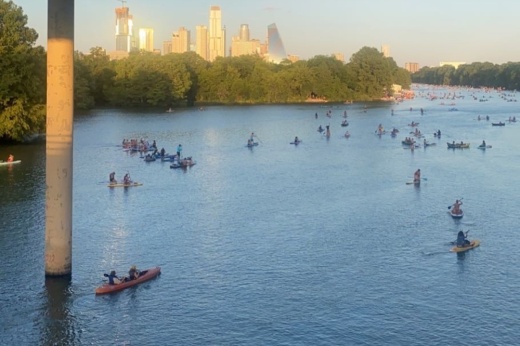Austinites are increasingly concerned about crowding on Lady Bird Lake, which receives an estimated 5 million visitors per year, according to a study conducted by researchers at Huston-Tillotson University.
The capacity study of Lady Bird Lake was presented during an Environmental Commission meeting March 1 by Amanda Masino, associate professor of biology and chair of natural sciences at Huston-Tillotson.
According to Masino, the study was conducted to discover the carrying capacity of Lady Bird Lake and how the Austin Parks and Recreation Department, or PARD, can address capacity-related challenges.
Carrying capacity refers to recreational, ecological, spatial and experiential capacity. This is the amount of watercraft that can be supported on Lady Bird Lake, organisms in the lake, parking around the lake and the social perception of crowding on the lake.
Recreational capacity
According to the study, the surface area of Lady Bird Lake is 471 acres, with a target density of 1 to 1.3 acres per boat.
“We might think of density as per unit area, but for this, you’re looking at the area per craft,” Masino said March 1. “That’s coming from the management perspective; how much space do you need for the operation of each boat?”
Over four days recorded in 2022, the study found a range of 188 watercraft on Friday, June 17, to 1,100 on Saturday, July 2. The highest totals occurred on Saturdays, regardless of a holiday or not.
According to the study, the recreational capacity was exceeded on peak weekends, including summer holidays, where the average density was 0.5 acres per boat, which is about twice as congested as the target density. On weekdays, the capacity is at an average of 2.34 acres per boat.
“We are indeed exceeding the carrying capacity of the lake on our sampled peak day, the weekends, whether it’s a holiday or not,” Masino said March 1. “On those days, the average whole lake density was about half of what it should be. We were able to identify the most heavily used segments of the lake, and so that presents an opportunity for perhaps managing some of this.”
On all four days, density was highest in the MoPac to Lamar area and lowest in the I-35 to Longhorn Dam area of the lake. The watercraft density in the MoPac to Lamar area was 12-22 times higher than the average density of the entire lake, according to the study.
Parking and Crowding
As part of the study, Austinites were surveyed on their opinions on crowding at Lady Bird Lake. The survey results revealed that the experiential capacity has been exceeded.
Inadequate parking was considered a concern by 49.1% of respondents. 58.5% of survey respondents expressed strong or moderate concern with lake crowding, and 57.2% with trail crowding. 61.4% of survey respondents experienced a loss of enjoyment due to lake crowding at least some of the time, according to the study.
Survey recommendations for PARD
While carrying capacity is not exceeded everyday, Masino recommends that Lady Bird Lake is monitored to address patterns of crowding and that increased human impact on the lake is addressed.
“We absolutely need to think about ways to reduce congestion,” Masino said March 1. “The segment between MoPac and First is the most critical.”
Masino addressed eight potential action items to address concerns found in the study:
- Reduce congestion by adding more formal access points and focus on amenities that spread usage;
- Increase connectivity by linking the Butler Trail system to other trails and parks;
- Offer programming outside of the congested zones;
- Offer public education on water and boat safety, trash reduction, and water quality and watershed protection;
- Increase diversity through outdoors education;
- Expand into volunteer programs and new roles;
- Increase environmental monitoring; and
- Strengthen enforcement through increased patrol, enforcement of unlicensed vendors and trash policies.
“Across the board is appreciation and concern for maintaining this precious status of [Lady Bird Lake],” Masino said March 1. “We had a really good level of agreement that Lady Bird Lake is one of Austin’s most important natural resources.”





